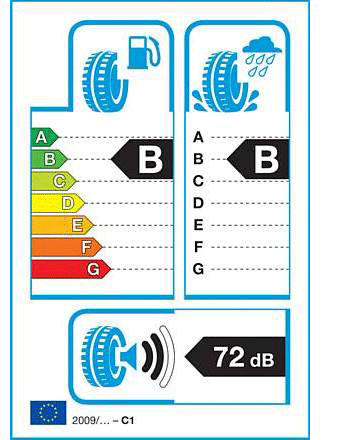New Tyre Labelling System
The information available to you when you buy car tyres is set to change for the better.

From November 2012 most new tyres – any produced after July – will carry a label giving you information about that particular tyre's wet grip, fuel efficiency and noise performance.
The same information will be available on websites and promotional material. This is the result of a new European regulation (1222/2009) aimed at reducing fuel consumption across Europe by helping motorists make better informed choices and encouraging the purchase of more fuel efficient tyres.
Overall, tyres are responsible for around 20% of vehicle fuel consumption and can affect fuel costs in two ways:
Tyre pressure –
Reduced tyre pressure increases rolling resistance and hence fuel consumption so you should check pressures regularly.
Materials and construction –
Tyre manufacturers can choose materials and manufacturing techniques to reduce rolling resistance at the recommended pressure.
If you're buying tyres however, bear in mind that while the information on the label is important it really tells you very little about a tyre's overall performance. The label doesn't include any information on many other important tyre characteristics such as:
Tyre life,
Dry road braking and handling,
Wet road handling and aquaplaning,
Comfort/ride quality.
Ask us for advice or check the results of independent tyre tests if, as is likely, these other factors are also important to you.
The Label broken Down:
Fuel efficiency (rolling resistance)
Using the same design as that used for the familiar energy labelling on fridges, freezers etc. the label will show the tyre's fuel efficiency on a sliding scale from A (best) to G (worst). The difference between the best and worst fuel consumption can be as much as 7.5% for cars. As well as introducing labelling requirements, EU regulations will introduce mandatory reductions in maximum permitted rolling resistance in two stages - November 2012 and November 2016.
By choosing to fit A-rated tyres over G-rated tyres, you will save an average of 7.5% in fuel a year. (Please note D ratings are not used).
Wet grip
Reducing rolling resistance too far can adversely affect stopping distance on wet roads. To make sure that safety standards are maintained at the same time as achieving environmental improvements through reduced fuel consumption, the EU is also introducing minimum levels of wet grip performance. The new label will show wet grip performance measured under strictly controlled conditions and rated from A (best) to G (worst). The difference in stopping distance between each grade will be one or two car lengths when braking from 50mph. Overall the difference in braking distance between best and worst (A to G) will be around 30%.
Noise
As well as their contribution to fuel consumption, tyres affect the environment because of the exterior noise they generate. To reduce noise pollution from road transport, tyre manufacturers must comply with regulations setting increasingly stringent maximum limits for the noise that tyres generate external to the car. The bottom part of the label shows exterior noise level, measured in decibels (dB). A single 'sound wave' shows that the tyre's noise level is 3dB better than the future European limit. Two black 'sound waves' shows that the tyre meets the future European limit. Three black 'sound waves' shows that the tyre only meets the current European limit for noise.
What's not included?
The regulations apply to passenger car tyres, light commercial vehicles and trucks, but they don't apply to:
- Retreads,
- Professional off road or racing tyres
- Studded tyres are excluded if the studs are fitted, but they do apply if the studs are not in place,
- Temporary tyres/space savers,
- Tyres intended only for cars first registered before 1 October 1990 Those with a speed rating less than 80 km/h (50mph) Tyres with a rim diameter of less than 254mm or more than 635mm